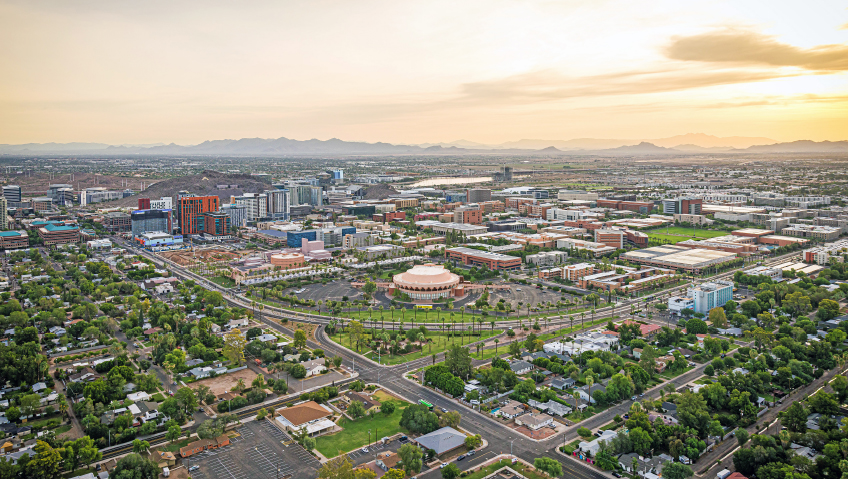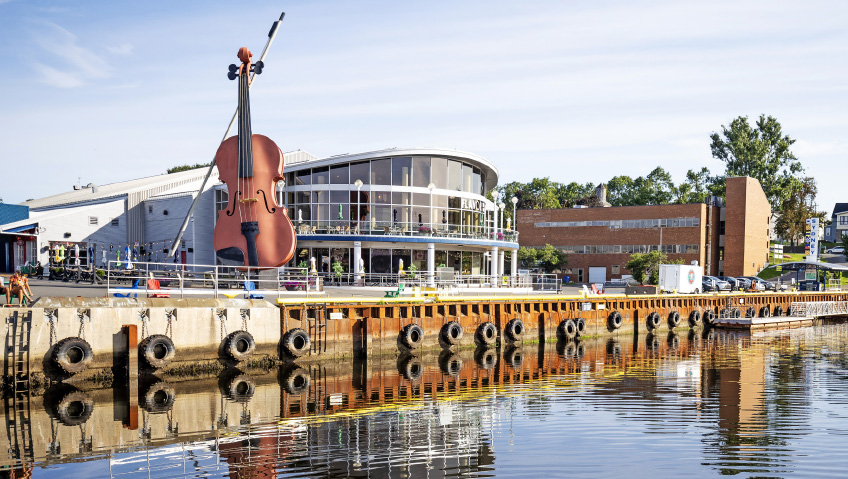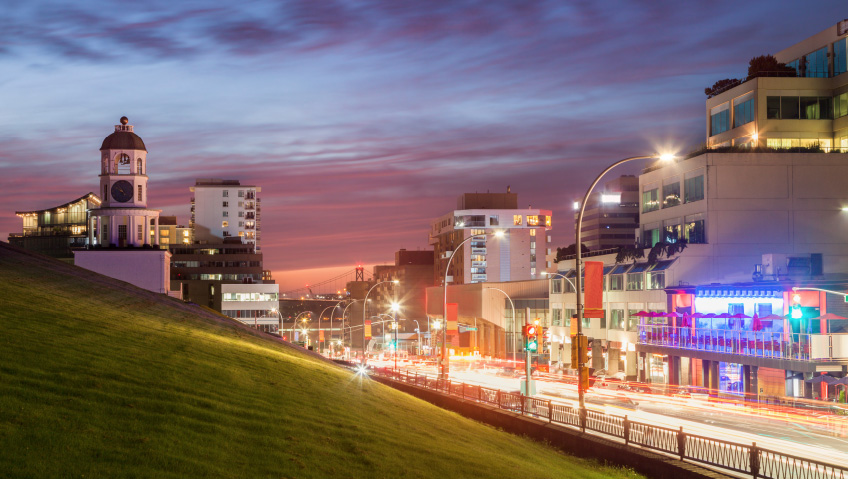Nestled alongside an unexpected desert lake, Tempe, Arizona has become an oasis for both work and play. When Business in Focus profiled the city of 190,000 residents in August of last year, we learned about the community’s commitment to business growth and livability. We checked back this month for updates on Tempe’s latest development projects.
Technology giants Intel and Taiwan Semiconductor Manufacturing Company Limited both operate within the region, creating an ideal environment for related businesses. Recent expansions at Intel have created even more opportunities for companies that support the technology sector.
“There’s been a tremendous influx of those types of support companies,” says Josh Rutherford, Economic Development Special Project Administrator for the City of Tempe. This is in addition to technology companies that were already operating in the city, such as Cactus Materials, Viasat, and Foresight Technology.
After more than 20 years in Tempe, Foresight Technology has some exciting expansion plans. “They purchased a lot next to them with an existing two-story office building,” Rutherford says. “They’re going to repurpose it into light manufacturing, which we like more of in Tempe. They’re going to invest substantial assets and people into that project and then as they grow even more, they’re going to possibly build a new building on site. Over the course of the next 10 years, they’re expected to add about 250 employees.”
Honeywell Aerospace also just completed an expansion that involved demolishing a multi-story office building and constructing two industrial buildings with office space.
Additional industrial projects will ensure that varied businesses will have the space they need in the future. The former Insight office building has been demolished and will be replaced with three new, state-of-the-art industrial buildings. The former site of Big Surf Water Park is currently being transformed into a new industrial park. In addition, developers are currently considering redeveloping one of Tempe’s large, two-story office buildings into three industrial buildings.
Arizona State University’s main campus is located in the heart of Tempe, and the university also has new development projects underway that will have a positive impact on the downtown. “It’s a several-hundred-acre piece of land that they’re moving forward with mixed-use development on,” explains Rutherford.
The city is also hard at work revitalizing the historic Hayden Flour Mill and silos. “Last year, there was a request for proposal put out for Hayden Flour Mill,” Rutherford says. “Tempe City Council will consider a Development and Disposition Agreement between Sunbelt Holdings and Venue Project on October 12. The first phase of that development agreement will include an inventory of original equipment left in the mill, rehabilitation of the trailhead, and general cleanup of the site.”
With so much development and business expansion underway, new employees relocating to Tempe will need housing. City planners are working hard to meet the upcoming demand and to make sure that there is housing available for all income levels. To this end, Tempe’s Hometown for All initiative was established in 2021 to provide options so that everyone can call Tempe home.
The City of Tempe recently purchased the former Food City site and two adjacent parking lots to create 400 housing units. “It’s going to be a mixed-income project with at least 50 percent affordable housing,” Rutherford shares, “and then the rest will probably be a mixture of market rate and workforce housing with a ground-floor grocer. This was one of the specific items in the request for proposal because we are experiencing what we believe is a food desert in that area. The need for grocery there is really high and so too is the need for housing.”
In addition, the City of Tempe purchased a nearby shopping center, “where we’ve relocated some tenants from the Food City site and, hopefully, within about three to five years, that site may get redeveloped as well into affordable housing.” The initiative also recently purchased a hotel and has converted it into transitional housing. Hometown for All is currently in the process of buying several vacant lots for future housing developments.
Private development has also taken off around Apache Boulevard. “From the private development side, there are probably about 2,000 units in the pipeline right now that have either been permitted or are currently under construction,” says Rutherford. “And there are probably another 1,000 to 1,500 that have not been permitted yet.” This means that there will be plenty of housing for incoming residents eager to take advantage of everything Tempe has to offer. “There are well over 3,500 units that will come online over the next few years.”
As these developments move forward, city leaders have officially acknowledged the historical and cultural significance of the historic homelands in Tempe of The Salt River Pima–Maricopa Indian Community (SRP-MIC) and Gila River Indian Community (GRIC). “They are a major partner in this development,” says Rutherford. “They sit at the table. We have monthly meetings with them. They’re apprised of every step that we’ve taken as far as the development agreement.”
In 2021, the City Council approved the resolution, which is now part of the city’s educational programs, ceremonies, and holiday observances and is considered when making decisions regarding land use and development. As listed on tempe.gov, the official statement is as follows:
“We wish to acknowledge that Tempe is the homeland of the Native people who have inhabited this landscape since time immemorial. Anthropological studies document large and advanced Ancestral O’Odham settlements located throughout the entirety of present-day Tempe and recognize the ancestral lands of the O’Odham (known as the Pima), Piipaash (known as the Maricopa), and their ancestors as extending far beyond our community. This land continues to be spiritually connected to the O’Odham of the Salt River Pima-Maricopa Indian Community and Gila River Indian Community. The SRP-MIC and GRIC, located northeast and south of Tempe, respectively, are confederations of two unique groups with their own languages, customs, cultures, religions, and histories; the O’Odham and the Piipaash. Both the O’Odham and the Piipaash are oral history cultures.
“The landscape is sacred to the O’Odham and Piipaash and reflects cultural values that are central to their way of life and their self-definition. Their oral history and song culture are indelibly tied to tangible places that are associated with specific historic, cultural, and religious values. Settlement patterns, advanced irrigation practices, and other lifeways driven by a deep understanding of and respect for the landscape are directly attributable to the ancestors of the O’Odham and Piipaash and served as the template for the establishment of Tempe. We accept the responsibility of stewarding those places and solemnly pledge to consider this commitment in every action.”
In addition, the Tempe City Council just “unanimously approved a city holiday observing Indigenous People’s Day,” Rutherford says. “That will be the second Monday of every October, starting this year.”
Looking ahead, the trend for Tempe will be continued development, particularly when it comes to multistory projects. “The urbanization of Tempe is going vertical,” Rutherford says. “As of last week, there are projects being approved that are upwards of 28 stories… I think we’re going to continue to see that high-rise, urban core density increase in the downtown. And then along our rail corridor, you’re going see a lot of mid-rise multifamily projects.”
From technology industry expansions to affordable housing developments, Tempe is preparing for tomorrow today, ensuring that businesses and residents will have their needs met well into the future.






